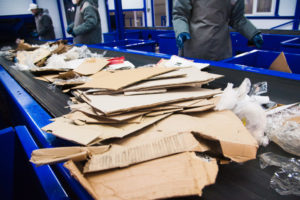The long-established need for a robust municipal solid waste (MSW) recycling system that prevents unnecessary waste from going to landfills, thus cutting greenhouse gas emissions, has led to record percentages of waste being recycled in recent decades. Recycling is now a $200 billion industry in the US, setting a pace that must continue in coming years if we are to heed warnings that there will be more plastic in our oceans than fish by 2050.
However, although we have increased the proportion of MSW that we recycle in the last few decades – 32.1% in 2018 – we are also generating more MSW than at any point in our history. And now that China no longer welcomes the import of US recycling, even more must be done at home to reduce the amounts of waste going to landfills.
In doing so, we should remember that recycling isn’t merely a problem to be solved but an opportunity to be exploited, and creating the conditions to ensure properly recycled materials form the backbone of a new, circular economy is the key to a sustainable future.
Here then, we look into the basics of existing recycling systems to get everyone on the same page and help you recycle better.
The Challenges Of Recycling
 The Environmental Protection Agency’s (EPA) own note on recycling basics tells us that recycling is the collection and processing of used goods and packaging into raw materials that can be used in the manufacture of new products. Indeed, many common consumer and commercial goods are already made from recycled materials, including newspapers, plastic bottles, car bumpers and trash bags. Often the manufacture of recycled products uses less energy with, for example, recycled aluminum taking 95% less energy to make than new aluminum.
The Environmental Protection Agency’s (EPA) own note on recycling basics tells us that recycling is the collection and processing of used goods and packaging into raw materials that can be used in the manufacture of new products. Indeed, many common consumer and commercial goods are already made from recycled materials, including newspapers, plastic bottles, car bumpers and trash bags. Often the manufacture of recycled products uses less energy with, for example, recycled aluminum taking 95% less energy to make than new aluminum.
But there remain significant obstacles to effective recycling, even with good intentions. Confusion about materials is among the biggest barriers to proper recycling and the main cause of contamination. Contamination is when a batch of recycling is tainted because of the inclusion of improper materials in its processing. Reducing contamination is one of just three key objectives the EPA set out in its National Recycling Strategy.
The recycling industry also suffers from an aging infrastructure that has not kept pace with increasingly diversified waste streams. A third issue is a reduction in demand for recycled materials as feedstock, and a fourth is a lack of effective measurement as a foundation for improvement. Nonetheless, there is much that we can do as businesses and individuals to improve our recycling basics and apply them in our homes and offices.
Recycling Basics
Understanding the different materials you can recycle curbside is step one of recycling 101. These days the information should be plainly stated on whichever containers your municipality provided you with. If not, you should be able to seek it out on your municipality’s website without any trouble.
Usually there are three primary recycling streams for households; plastics, paper, and glass, although this may differ depending on your location—many curbside services now include organic food waste for example. The specifics of what falls under each recycling stream can also change from state to state and on a local level, so it is essential to check local guidelines.
The recycling statistics for some specific waste streams in the US reveal serious national failings and gaps in knowledge. The EPA informed us in 2018 that just 9% of the plastic we produce is recycled. That leaves 89% of all plastic littering our planet. Tragically, some of this is down to people believing they are recycling efficiently when they’re causing more harm than good. One such mistake is throwing all plastic waste into your plastics recycling container. While most plastics may technically be recyclable, most curbside collection services only accept certain types. Making sure you understand which is up to you.
When we mix the wrong materials in our recycling bins (contamination) they cannot be effectively processed at recycling centers and whole batches may be rendered useless. E.g. When plastic grocery bags are put in plastic recycling they can clog up machines costing time and money. Plastic bags require specialist equipment and you’ll often find drop-off recycling points in local shops.
Another way people unwittingly cause contamination is by tossing mixed material items (e.g. a plastic and paper mail bag) into one or the other container. Unless these materials can be separated by yourself, they should not be recycled and it is far better to throw a material you are uncertain about in the regular trash bin rather than recycle it speculatively.
If you add it to a recycling bin it could contaminate an entire batch of raw materials, meaning all that good material will go to landfill because of one bad item. Sometimes a plastic product can be recycled but may require a specialist facility that municipal authorities don’t have access to. Bubble wrap is a good example of a recyclable material that doesn’t belong in your plastics recycling container at home.
It’s worth noting here that the ubiquitous chasing arrows symbol displayed on a product or packaging does not necessarily mean you can recycle the item curbside, or that it is necessarily recyclable at all. When the triangular symbol has a number from 1-7 inside this denotes the type of plastic used (3-7 are usually not recycled curbside). Confusingly, businesses are allowed to deploy the symbol even if the product isn’t recyclable, although some states including California, Maine, New York and Oregon are already overhauling laws to prevent such use.
Preparing Materials
Another key to avoiding contamination is to clean items before placing them in your recycling. Commonly, this means getting rid of food residue or dirt from glass bottles and plastic food containers. If materials carry too much grime and grease they can disrupt the recycling process by damaging machinery. This not only spurns the chance for recycling but leads to additional greenhouse gasses. 
Knowing when a recyclable material can no longer be recycled is as important as separating recyclable and non-recyclable materials. For example, heavily soiled cardboard pizza boxes will never be processed into high-quality paper pulp. So cut off the greasy sections and recycle the clean part (machines can deal with a little residue so it doesn’t need to be spotless).
Many items we assume are 100% paper and recyclable in our paper bins, are not. For example, coffee cups (plastic lid removed of course) are rarely 100% paper. They usually include a plastic lining that isn’t welcome in the paper pulping process. The same goes for freezer boxed goods like fish sticks. The solution to these nuances is to read the packaging for before you recycle or throw something out. Along with a clear understanding of your local recycling rules, you can now avoid the majority of contamination with these recycling basics. And once you have that mastered, you’ll be free to spend a little extra time identifying which materials can’t be recycled curbside but that could still be recycled nearby.
Recycling In A Circular Economy
Going zero waste is all about taking a step back and seeing the bigger picture of the waste we create. Recycling is one strategy to reduce waste and cut greenhouse gas emissions but there are other actions we can take before we resort to recycling. The EPA refers to this approach as a circular economy because it simultaneously aims to reduce the mining of raw materials, while taking the waste we do produce and redirecting it toward the manufacture of new products. The aforementioned National Recycling Strategy was created to help move toward a circular economy.
Creating a circular economy might feel like a lofty goal for individuals and small businesses but there is a lot to be done on a smaller scale that can contribute to a national change of habit. Holistic waste management informs us of the steps that come before recycling; prevention, minimisation and reuse.
For households, prevention and minimization could mean replacing single-use and disposable items with more durable and sustainably made zero-waste alternatives. Or, seeking out packaging-free products at local markets instead of plastic-wrapped supermarket goods. Reuse could mean repurposing or donating clothing instead of recycling it. A good example of this sort of pre-recycling intervention is in the case of organic food waste. While recycling or composting of food waste seems like a productive action, food waste is far more useful when donated to those who could eat it, or directed towards biofuels.
How The US Can Recycle Better
 We have seen how the effectiveness of the recycling industry can be hampered at the consumer level by contamination and we have covered the recycling basics you can pick up to avoid this. But the recycling industry suffers from a lack of standardization across the United States.
We have seen how the effectiveness of the recycling industry can be hampered at the consumer level by contamination and we have covered the recycling basics you can pick up to avoid this. But the recycling industry suffers from a lack of standardization across the United States.
In order for households to meet the challenge set by the EPA, more clarity and uniformity is needed on what can and can’t be recycled and where. Right now everyone can do their part by mastering the recycling basics we’ve set out above; understanding local guidelines, reading packaging and preparing their own recycling accordingly.
For more information on how both individuals and businesses can improve recycling and optimize waste management, subscribe to the RTS blog today. Additionally, for tailored insights into your waste management practices, contact one of our LEED-accredited advisors.

